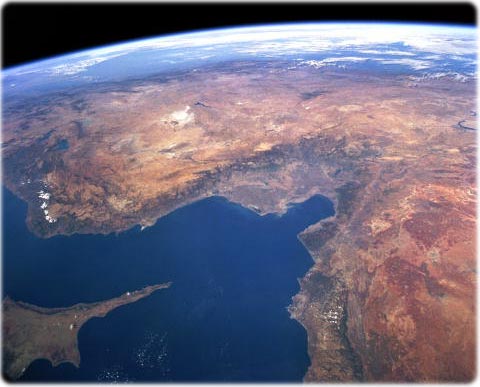
Images of Asia from Space
Valley of the Brahmaputra River, extreme Northeast India (low-oblique photograph from NASA, edited, November 1990). This image shows the physiographic relationship of the eastern Himalaya Mountains to one of the wettest river basins on the Planet. Known as the Dihang River where it cuts through the eastern Himalayas, creating great gorges, numerous tributary streams, and alluvial fans, the deeply incised Brahmaputra River is highlighted as these channels break through the geologically young, uplifted folds of the Himalayas just north of Sadiya, India. The summer monsoons that India and Bangladesh depend on for most of their annual precipitation largely determines the quantity of water that will be transported through the Assam Valley of northeastern India, which receives rainfall amounts in excess of 500 centimeters annually.
Hijaz Mountains and Nafud Desert, Saudi Arabia. The dissected Hijaz Mountains and the northwestern portion the Nafud Desert of Saudi Arabia are visible in this high-oblique, northwest-looking photograph. The barren Hijaz were formed by the uplifting of the eastern flank of the Great Rift Valley that runs through the basin of the Red Sea (west of the range). The narrow coastal plain between the mountains and the sea is extremely desolate. East of the mountains are the orange sands of the Nafud Desert, known for its sudden violent winds that have formed many great crescent-shaped dunes (barely discernible near the north center of the photograph). The desert, occupying a great oval depression, is surrounded by sandstone outcrops that have been eroded into grotesque shapes by these strong winds. Rainfall occurs once or twice yearly in the region. Near the south and southeastern portions of the photograph, dark lava flows from ancient volcanoes stand out. Near the horizon are the Gulf of Suez, the Sinai Peninsula, the Gulf of Aqaba, the eastern Mediterranean Sea, and the western half of the Syrian Desert (NASA - June 1991).


The Mediterranean Sea and central Turkey dominates this north-looking panorama (NASA).




This image comprises data collected by instruments on Suomi-NPP and NOAA-20, on March 8, 2020. It features the northern Indian Ocean and the surrounding portions of Africa and Asia. Conspicuous in the Arabian Sea are dense blooms of Noctiluca scintillans that have been plaguing the region in wintertime for many years now (source NASA).
Eruption of Klyuchevskaya volcano, in 1994, in Kamchatka Peninsula, Siberia, Russia. Both lava and ash explosions occurred during this eruption. Klyuchevskaya Volcano is reported to be Kamchatka’s highest (4750 m) and most active volcano (NASA).

|
Copyright © Geographic Guide - Images of the Planet. |
Black Sea and parts of Europe and Asia (NASA - May 29, 2017). The turquoise swirls in the Black Sea indicate the presence of phytoplankton, which trace the flow of water currents and eddies.
